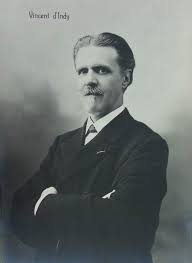VINCENT D’INDY AND THE GODDESS ISTAR
The great Ishtar, goddess of love and war has been the inspiration of a composition by Vincent d’Indy in 1896.
VINCENT D’INDY
Vincent D’Indy (Paris 1851-1931) was born into an aristocratic family in Paris. He began studying piano when he was young under the supervision of Diémer and Marmontel. D’indy studied law, but after degree he went to the conservatory in Paris and was a pupil of César Franck. From the age of 14 he studied harmony with Albert Lavignac. He founded the Société Nationale de Musique, of which he was president and the Schola Cantorum with Charles Bordes and Alexandre Guilmant,when he taught until his death. He has composed numerous works including Symphonie Cévenole and Ishtar, Opus 42.
ISHTAR (OPUS 42)
In 1880 the exhibition of Assyrian sculptures in the British Museum and the discovery of the first mythical texts had sparked D’Indy’s enthusiasm. In fact the opera “Ishtar” comes from a Mesopotamian epic poem. This work is really amazing, not only for its artistic value, but also for its source and inspiration. In the poem (from which the work originates) the goddess Ishtar traveled to underworld to reach his beloved Tammuz. The Underworld has seven gates (the gates of the Hell), she has to bare of her garments and ornaments (like the tiara, the belt, the anklets) to each these. This is the background of the composition of this great performer and, here, Ishtar naked, is presented as the sensual goddess of the culture of the Near East, but her character warrior becomes vulnerable and fascinating. The composition has seven variations.
Maybe to read this ancient myth accompanied by the symphony of this composer shows an unprecedented atmosphere.
VINCENT D’INDY E LA DEA ISHTAR
La grande Ishtar, la dea dell’amore e della guerra è stata l’ispirazione della composizione di Vincent d’Indy nel 1896.
VINCENT D’INDY
Vincent D’Indy (Parigi 1841-1931) è nato in una famiglia aristocratica di Parigi. Ha iniziato a studiare pianoforte quando era piccolo sotto la supervisione di Diémer e Marmontel. D’Indy studiò legge, ma dopo la laurea andò al conservatorio di Parigi e divenne alunno di César Franck. Dall’età di 14 anni studiò gli accordi con Albert Lavignac. Ha fondato la Société Nationale de Musique, di cui divenne presidente e la Schola Cantorum con Charles Bordes e Alexandre Guilmant, dove insegnò fino alla sua morte. Lui ha composto numerose opere tra cui Symphonie Cénevole e Ishtar, Opus 42.
ISHTAR (OPUS 42)
Nel 1880 l’esposizione delle sculture assire all’interno del British Museum e la scoperta dei primi testi mitici ha suscitato l’entusiasmo di d’Indy. Infatti l’opera “Ishtar” deriva da un poema Mesopotamico. Questo lavoro è davvero stupefacente, non solo per il suo valore artistico, ma anche per la sua origine e ispirazione. Nel poema ( dal quale l’opera trae origine) la dea Ishtar viaggiò verso gli Inferi alla ricerca del suo amato Tammuz. Gli Inferi hanno sette porte (le porte dell’Inferno), lei si deve denudare delle sue vesti e ornamenti (come diadema, cintura e cavigliere) ad ognuna di esse. Questo è lo sfondo della composizione del grande artista e , qui, Ishtar nuda, è presentata come la dea sensuale della cultura del Vicino Oriente, ma il suo carattere guerriero diviene vulnerabile e affascinante.
Forse leggere questo antico mito accompagnato dalla sinfonia di questa composizione mostra un’atmosfera senza precedenti.
